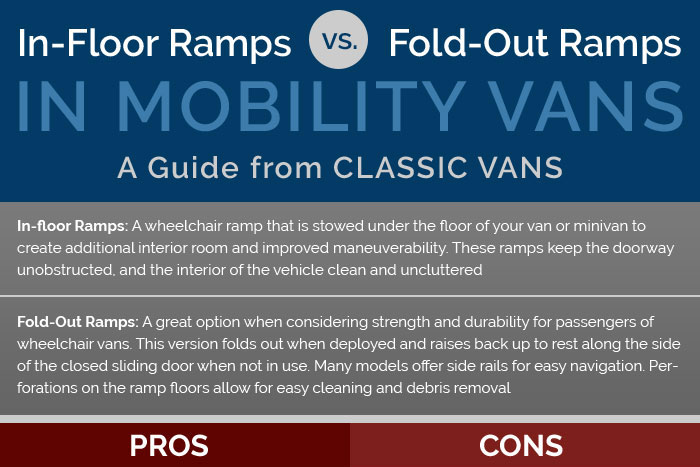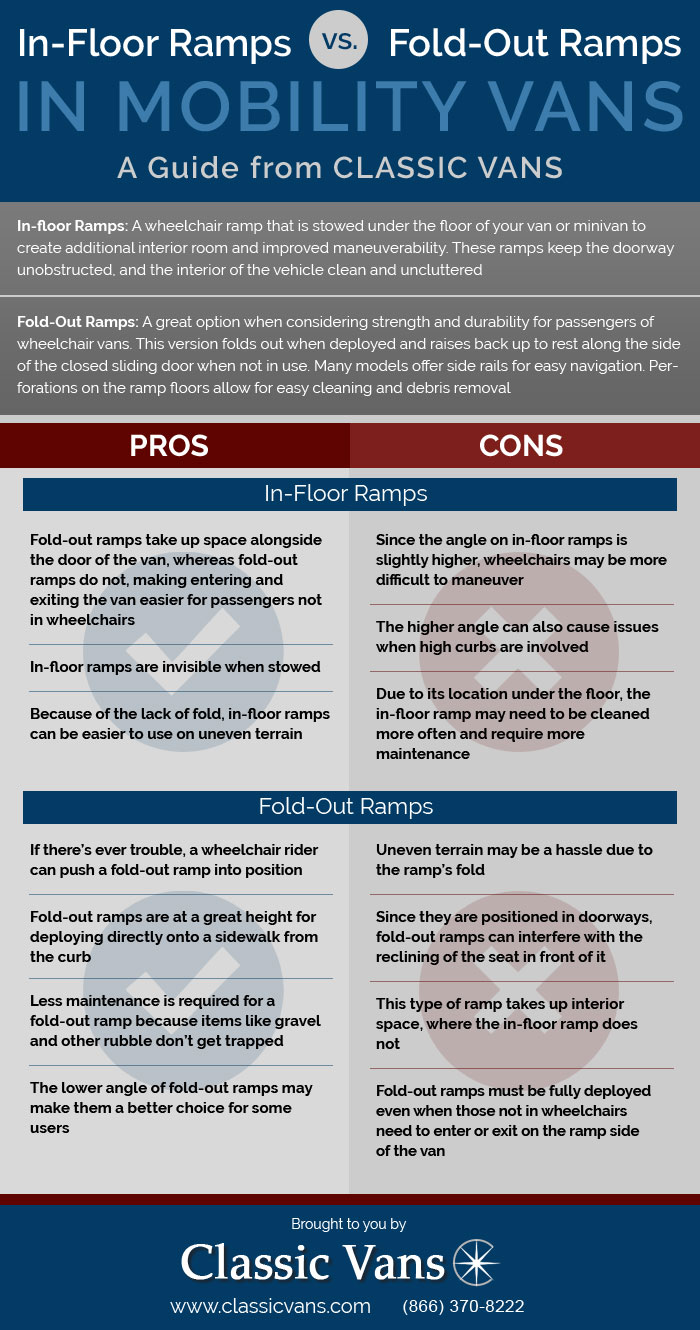Compare different wheelchair ramp options and find out what questions you should be asking before buying a custom van for you or your loved one with this guide from the mobility experts at Classic Vans
by Jonathan Carey, Owner, Classic Vans
If you’re in the market for a new or used wheelchair van, you may be feeling a little overwhelmed. There are so many options and customizations; no two vans are the same!
When you add in considerations like how much space may be needed for other considerations and what sort of parking situations you’ll need to accommodate, it might start to seem like there are an awful lot of decisions to make.
Click here to view full infographic
Wheelchair ramps are often recommended because they’re flexible and affordable options that provide safe, easy loading and unloading of wheelchairs and their riders.
There are a few different types of ramps to consider, but the two most common are in-floor and fold-out ramps. Each has its own advantages, so we’ve created this guide and infographic to help you make the best choice for your needs.
We at Classic Vans have been guiding our customers through those decisions for 30 years, and we’ve learned that one of the most important choices you’ll make when you purchase a conversion van for wheelchair travel – assuming you’ve chosen to go with a ramp instead of a wheelchair lift – is whether to choose an in-floor or fold-out ramp.
What are the main differences between in-floor and fold-out wheelchair ramps?
First, let’s start with some basic definitions:
In-floor Ramp – An in-floor ramp is a wheelchair ramp that is stowed under the floor of your van or minivan to create additional interior room and improved maneuverability.
These ramps keep the doorway unobstructed, and the interior of the vehicle clean and uncluttered.
Fold-Out Ramp – A fold-out ramp is a great option when considering strength and durability for passengers of wheelchair vans. This version folds out when deployed and raises back up to rest along the side of the closed sliding door when not in use. Many models offer side rails for easy navigation. Perforations on the ramp floors allow for easy cleaning and debris removal.
Pros and Cons of In-Floor and Fold-Out Ramps
So the broad strokes are that one type of ramp is stored in the floor and has no fold, and the other is stored alongside the doorway and does have a fold. What does that mean in practical purposes, though? Mainly that there are some differences in function, space, and convenience depending on where and how you’ll most often be using the ramp and your van in general.
Check out this list of pros and cons for a little more detail…
Pros of In-floor Ramps:
- Fold-out ramps take up space alongside the door of the van, whereas fold-out ramps do not, making entering and exiting the van easier for passengers not in wheelchairs
- In-floor ramps are invisible when stowed
- Because of the lack of fold, in-floor ramps can be easier to use on uneven terrain
Cons of In-floor Ramps:
- Since the angle on in-floor ramps is slightly higher, wheelchairs may be more difficult to maneuver
- The higher angle can also cause issues when high curbs are involved
- Due to its location under the floor, the in-floor ramp may need to be cleaned more often and require more maintenance
Pros of Fold-Out:
- If there’s ever trouble, a wheelchair rider can push a fold-out ramp into position
- Fold-out ramps are at a great height for deploying directly onto a sidewalk from the curb
- Less maintenance is required for a fold-out ramp because items like gravel and other rubble don’t get trapped
- The lower angle of fold-out ramps may make them a better choice for some users
Cons of Fold-Out:
- Uneven terrain may be a hassle due to the ramp’s fold
- Since they are positioned in doorways, fold-out ramps can interfere with the reclining of the seat in front of it
- This type of ramp takes up interior space, where the in-floor ramp does not
- Fold-out ramps must be fully deployed even when those not in wheelchairs need to enter or exit on the ramp side of the van
Questions to Ask Before Buying a Mobility Van
If you are still unsure of which type of wheelchair ramp you need in your van, consider these questions to help guide you through the decision-making process:
How important is it for those not in wheelchairs to have access to rear seating?
Are you frequently traveling with passengers who will be sitting in the third row? Is it important that they have easy access to all available seating to accommodate larger groups? An in-floor ramp will probably be the best bet for you if passenger accessibility is important. The stowing of this ramp under the van’s floor allows for less obstruction, making it easier for passengers to go back and forth.
Do you need storage space to transport other items in your van?
On a similar note, the increased space makes it easier to accommodate supplies and other assistive equipment you may need when traveling.
Does the wheelchair rider use adaptive seating in the van?
If the person in a wheelchair is a passenger and uses adaptive seating to help with positioning during travel, the passenger seat may need to be reclined to accommodate their chair. In these cases, fold-out ramps can be inconvenient, and an in-floor ramp may be a better choice.
How important is front passenger comfort?
One of the advantages of an in-floor ramp is the person riding in the front passenger seat has full ability to recline. When using a fold-out ramp, the front seat’s capacity to recline will be restricted when the ramp is stowed. If you find that you are using your van for short trips only, this issue may not be important. However, if you plan on spending time behind the wheel with a passenger commonly riding shotgun, you may want to take their comfort into account.
How much time do you spend visiting areas with uneven terrain?
If you live in a hilly area or like to spend time outdoors, you might find an in-floor ramp easier to deploy because the lack of fold gives a bit more adjustability.
Do you live in a climate with lots of rain or snow?
If you live in a climate with high amounts of rain, snow or even falling leaves, an easy-to-clean in-floor ramp might be a more practical choice. With a fold-out ramp you could find yourself with a pile of leaves or melted snow inside the cabin after folding up the ramp.
Who’s the manufacturer?
Braun and VMI are the two leading manufacturers. When doing your research on purchasing wheelchair vans, it would be wise to see what both companies have to offer.
Though both companies make quality conversions, VMI’s in-floor ramp has been found to offer more space and interior headroom compared to Braun.
For example, on Toyota Sienna chassis you will get a door opening height of 57 inches. With a VMI ramp installed, the floor length behind the front seat is 60 inches, while Braun’s competing product offers just 51.
How price-sensitive are you?
Ramp conversions are a huge investment. A conversion on Toyota Sienna, for example, can run between $23,000 and $28,000. Here are some price points to consider:
- An in-floor ramp will cost at least $1000 more than a fold-out.
- Braun conversions will most likely cost more than VMI.
Each ramp type has its strengths and weaknesses. Doing your research and knowing exactly what you will need from your conversion van can ensure you end up with one that fits your needs perfectly.
Do you plan to use the van in an environment with tall curbs or steep gradients?
Steep gradients and tall curbs can pose issues when deploying the van’s ramp. Of the two types of ramps, a fold-out may be better for this situation. If you are faced with a tall curb, an in-floor ramp may not be able to go over it.
Have questions we didn’t cover here?
Classic Vans is an NMEDA-certified (National Mobility Equipment Dealers Association) dealer that you can trust to provide with the tools you need to build the best possible custom mobility van. Our team is dedicated to helping you make the right choices when buying and equipping mobility vans for wheelchair travel.
Browse through our full-size wheelchair vans and accessible minivans, and contact us when you’re ready to speak with a mobility specialist about your next automobile.

